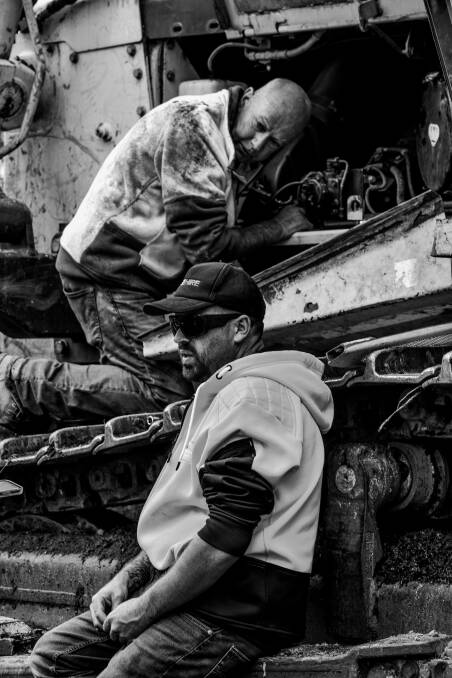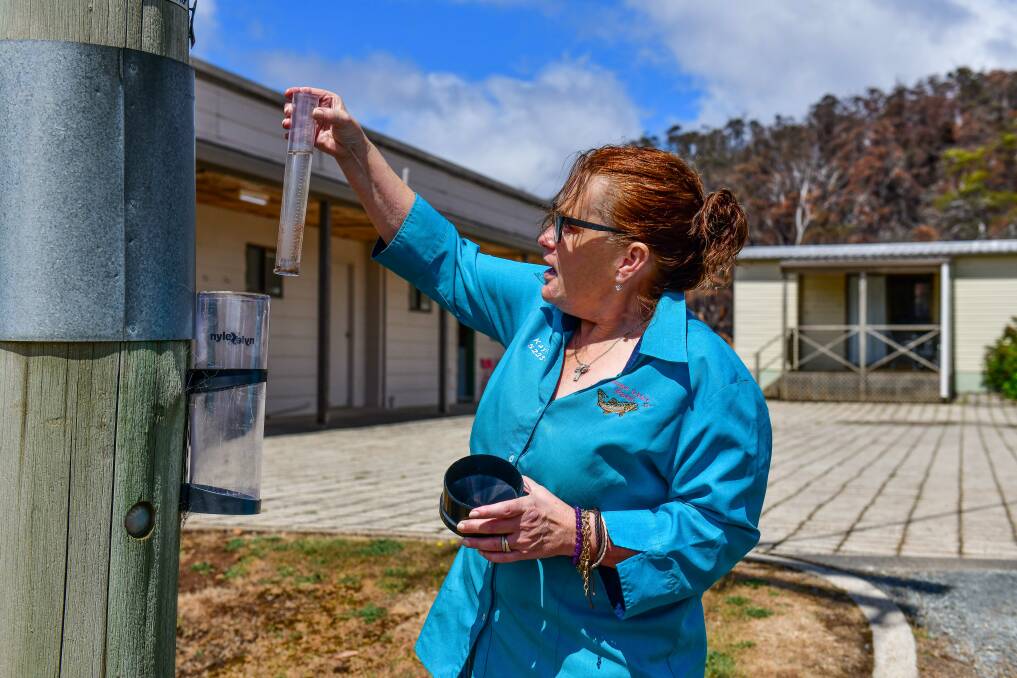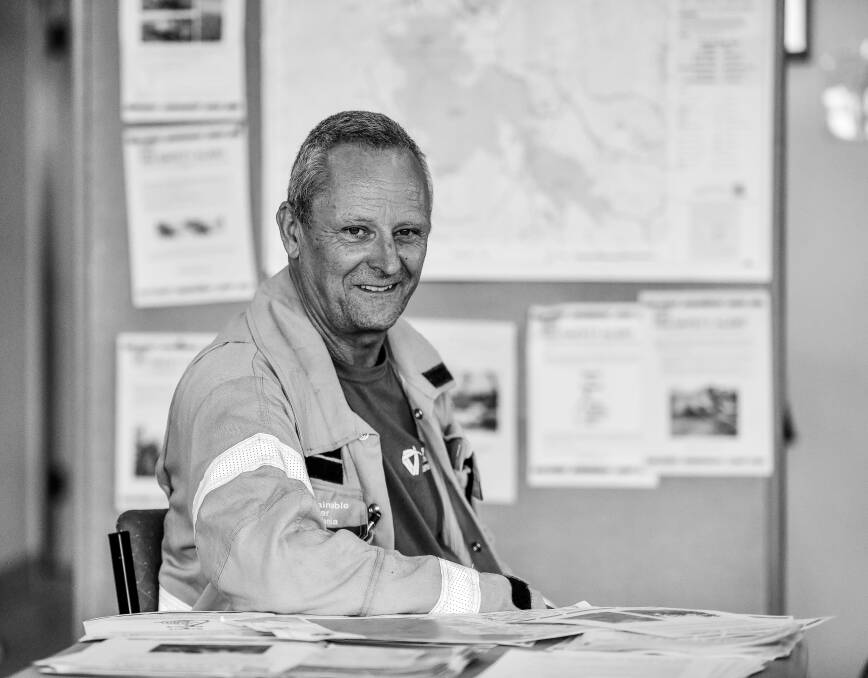In the blackened, Central Highlands town of Miena, everyday life has taken on a strange new normality.
Subscribe now for unlimited access.
$0/
(min cost $0)
or signup to continue reading
For more than three weeks, since January 15, the areas usual summer population of fishers, hikers, and about 2000 shack-owners has been replaced by a rotating roster of Tasmania Fire Service, Parks and Wildlife, Sustainable Timber Tasmania, State Emergency Service, Tasmania Police, and contracted specialist staff, working around the clock to combat the 55,000 hectare blaze chewing through the pristine conservation area and repeatedly threatening the town.
For the emergency service workers that have been in the thick of it, the horrors of the blaze have been immediate and gut-turning.
They describe gnarled trees turned bone-white by flames burning at 300 degrees Celsius. Wallabies and pademelons throwing themselves into the swallowing wall, overcome by fear and confusion. Pillars of fire, as far as the eye can see, stretching into a sky of furnace-orange smoke, as flames lick the sides of ancient trunks and turn them into flickering towers of red.
But among the horror, life goes on.

For three weeks, more than a hundred volunteers have needed three meals a day and beds to sleep in at night. There is still humour, camaraderie and baked goods in the town - provided by the 40 or so permanent residents of Miena that have stayed behind to help.
The bustle of activity swirls around the Miena Community Centre. A place of band nights, trivia, and art workshops under normal circumstances, the smart brick-and-timber building has been filled with bulletin boards bearing maps, tables heaving with scones and slices, and stackable chairs. Emergency service staff sit around on their breaks, checking their phones and chatting about the operations of the day. In the kitchen, the Miena Community Centre Committee directs the town's volunteers, putting them to work washing dishes and pulling cakes out of the oven.
"We cant fight fires, but we can feed them," committee member Toni Glowacki said.
"We try and keep the hall clean provide fresh food. We do things like scones, sausage rolls, make a cake, that sort of thing - in a dodgy oven."
"It burns on one side," laughed community volunteer Kath Humphris.
"And doesnt cook through in the middle. It takes ages - but we manage. We call them bushfire sausage rolls, because they get a bit burned on the outside."
"Everyone keeps thanking Linda [Smith, Committee president], and I, but its everyone," Toni Glowacki said. "Weve had our little quiet army."
"Linda and I describe ourselves as the hinges on the door. Our volunteers are the door, and were just here to make it work."
That door consists of about 30 helpers running in and out of the centre. Along with residents, there is also talk of tourists who came up to the Great Lake for a spot of fishing, and ended up spending their entire holiday peeling potatoes and learning how to bake scones for the firies.
In the evening, the action moves to the Great Lake Hotel. The atmosphere at the hotel after five is not dissimilar to any country pub after knock-off - except that everyone is wearing uniform and covered in ash. And the beer is free.

Co-owner Kaylee Hattinger is a hard woman to pin down. Shes one of the most open, friendly people you'll meet in your life, but she is busy. Along with chef Alfredo Quines, and the hotel staff, shes been serving up close to 300 meals a day - a packed lunch and a hot dinner for each emergency service worker who needs it.
Ms Hattinger is a one-woman logistics powerhouse. She's on the phone with the TFS operations centre, coordinating beds. She's on the phone with everyday people, wanting to know if the roads have reopened. She's pouring beers; for the contracted bulldozing team who have been working 12 to 16 hour days for 22 days straight, and for the West Australian specialist Parks and Wildlife crew who have been cutting firebreaks by hand in the hilly terrain.
Throughout Miena there is exhaustion in the air, but also humour. The committee ladies joke to the firefighters as they get changed out of their uniforms about making a calendar, and behind the bar, Ms Hattinger chides the workers to wash the soot off their hands before they eat.
But ever-present, is the reminder of why everyone is here.
It was a Monday when the fire encroached on the outskirts of the Community Centre.
The flames licked up Cider Gum Road and Fleming Drive towards the middle of Miena, roaring behind the hill opposite the building.
The thing that anybody who has been in the path of the fire talks about is the noise.
Bushfires produce their own sound, a sound like nothing else on earth. It's the sound of the fire pulling air into its own weather system, at the same time as it feeds on the wind - 100 kilometres per hour, some days - and turns debris into ash.
"A huge, big freight train is the only word you could use," Toni Glowacki said.
"It's like a jet engine taking off in an airport," Parks and Wildlife WAs Craig Popperwell said.
"I was on the road coming back from Bothwell when it cut in front of me, and all you can hear is the roar - it's like being inside a burning tunnel," Sustainable Timber Tasmania's Stewart Johnson said.

Sitting on the deck of the community centre, the Miena residents couldn't see the flames. The noise, and the smoke, were the only sensory evidence of its presence bearing down on the town.
"It's the sitting and waiting that I think is the hardest part," Toni Glowacki said.
The helicopters started bringing water down, and the water was evaporating before it got to the ground.
- Toni Glowacki
"It would come up, and then it would die down, and then it would come again. The helicopters started bringing water down, and the water was evaporating before it got to the ground. That's how hot it was.
"And it just came.
"The noise from the helicopters...you couldn't talk out here. And how they didn't hit each other, I've got no idea.
"The amount of water they put on that patch up there, just to save us ... without that aircraft, Miena would not be here."
But Miena is still there. Thanks to the aircraft, and the volunteers, and the paid staff, and the little group of resilient locals who wouldn't let their town burn down.
This week, the mood in the town is one of cautious optimism. Rain has finally come. The Bureau of Meteorology is predicting a series of cold fronts. As it always does at the Great Lake, the wind will continue to whip up a frenzy, and it will be months before all of the hot spots smouldering in the peat completely go out - but conditions have calmed. There are even rumours of snow coming this week.

Soon, the only physical evidence of the fire will be the acres and acres of black, ravaged wilderness, and the sole shack that burned down in the Central Highlands. But this extraordinary three weeks will not soon be forgotten by the extraordinary people who have lived through it in Miena.
If you're so inclined, Kaylee Hattinger has a suggestion for how to say thank you: go down to your local TFS brigade, and buy them a carton of beer.


